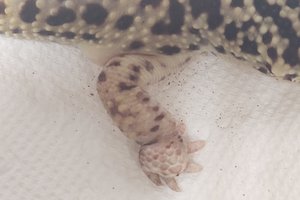
Gout is defined as the deposition of uric acid crystals within or on the surface of organs and/or within the joints. Common causes include kidney disease, chronic dehydration, or dietary issues. Diets too high in protein or those too high in purines can cause gout, especially in bearded dragons and leopard geckos. The most common dietary culprit in these species is a diet almost exclusively of Dubia roaches.
Patients with gout present to the veterinarian with swelling of joints, white deposits in the oral cavity or joints, and dehydration. Those with gout secondary to kidney issues may present with enlarged kidneys, or constipation and non-specific signs including anorexia, lethargy, and depression.
The following conditions may have similar clinical signs: joint abscesses, cysts, joint disease, cancer, or peri-articular pseudogout (calcium deposits surrounding the joints).
Your vet will start with a fine needle aspirate of any affected joints to look for the presence of uric acid crystals. From there they may recommend further testing to determine the overall health of your pet, including a complete blood count, serum biochemistry panel, and radiographs.
Treatment involves decreasing the uric acid levels in the blood with a prescription medication called Allopurinol as well as pain medication and any changes to the animal's care and diet that may be necessary.
In cases of kidney disease, this is a lifelong condition that carries a guarded to poor prognosis. This is a condition where quality of life should be evaluated frequently and once it is poor the prognosis is grave and euthanasia should be considered. Patients who develop gout secondary to diets high in Dubia roaches on the other hand carry a much better prognosis and with treatment and diet improvements clinical signs can resolve giving them a fair to guarded prognosis.
Depending on the patient condition your veterinarian will recommend rechecks to evaluate response to treatment.
Copyright © All Rights Reserved